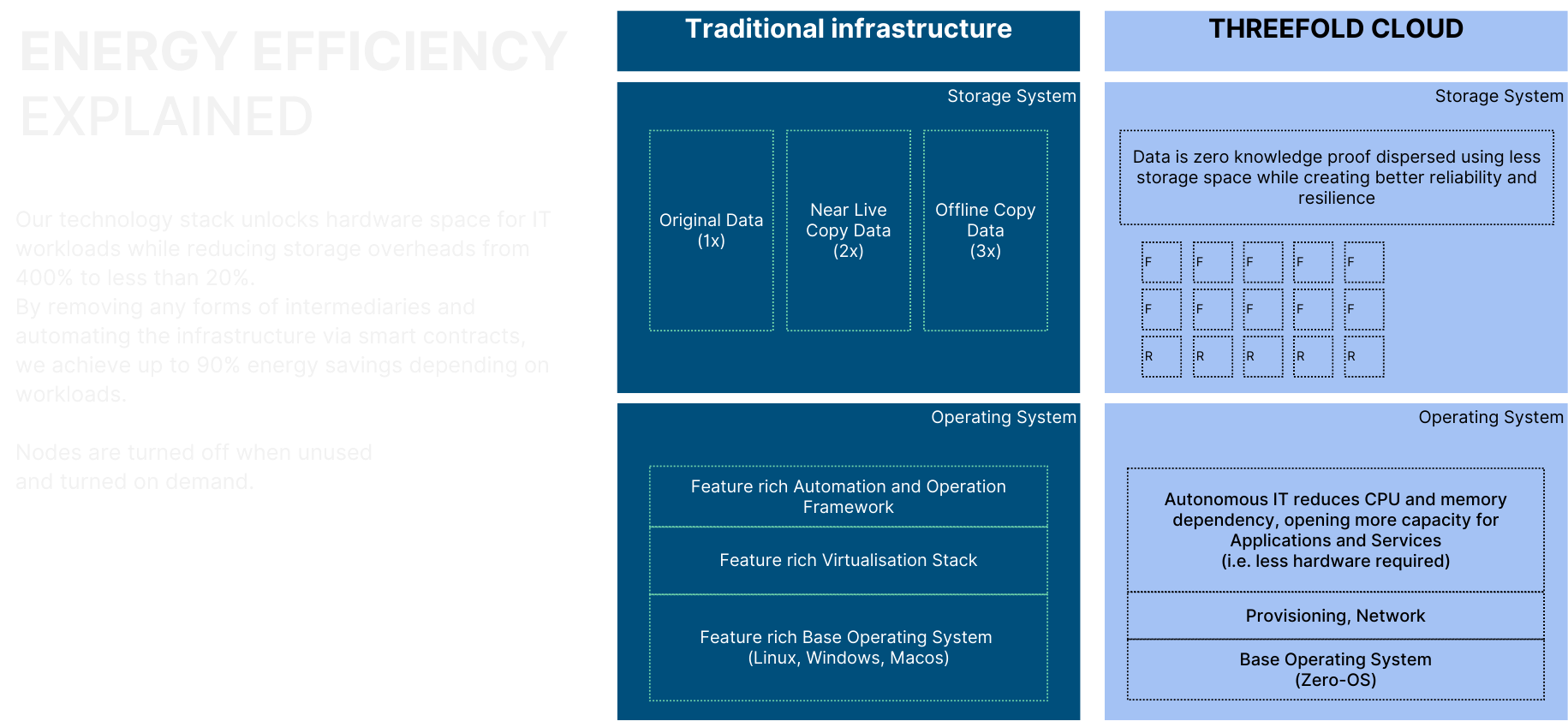Energy Efficiency Architecture
The distributed architecture implements several technical approaches to achieve energy efficiency compared to traditional centralized models.

Special Usecase = energy efficient "hero" app
Why the Hero Personal Agent can be upto 10x More Energy Efficient
The Hero Personal Agent is not just smarter, it’s radically more sustainable.
Here's a breakdown of how we achieve this dramatic energy efficiency, rooted in technical design choices across storage, compute, and network presence.
Compute Efficiency: Less Overhead, More Focused Work
Typical cloud applications involve many layers of software abstraction, leading to excessive context switching and CPU waste.
Hero runs on a stateless, minimal operating system (ZOS), with each node running thousands of microservices without unnecessary virtualization or kernel level noise.
- Less context switching = more efficient CPU cycles per task.
- Near-zero idle CPU usage due to event-driven architecture.
Result: More work done with fewer watts, your Hero runs lean.
Existence Model: One Copy, Not Hundreds: the most important factor
In conventional cloud setups, your digital assistant or app might exist in multiple copies across services, backups, regions, etc. That’s a lot of redundant computation.
You exist 100x, facebook, linked in, google, ...
Hero Apps follow a “single-instance” model:
- Your assistant exists once on the decentralized grid.
- It is stateful, reliable, and doesn’t need to be duplicated across data centers.
- It’s available to you anywhere, but doesn’t spin up new processes all over the web.
Result: One Hero = one compute instance. Not 100.
Efficient Storage Architecture: Less Hardware, Slower Disks, Same Reliability
Traditional storage systems replicate data 3 or more times (blockchain much more) across disks. Hero’s infrastructure uses forward-looking error correcting codes, which achieve the same or better reliability using far fewer disks.
- Up to 5x fewer disks are needed to store the same amount of data.
- We use “green” slow-spinning disks. These disks are cheaper, use far less power, and can have longer lifespans if in liquid cooling.
Result: Less storage hardware, lower energy per byte stored.
Energy per Hero: Less Than 1 Watt
A typical edge ZOS node on our grid typically uses 60 watts.
- A single node can run 100 to 200 Hero Apps, depending on workload.
- This breaks down to ~0.3 to 0.6 watts per Hero App.
That’s less than a small LED lightbulb per digital assistant, while still maintaining security, responsiveness, and availability.
Result: A global digital assistant platform with minimal energy footprint.
Summary Table
| Component | Traditional Systems | Hero Platform | Efficiency Gain |
|---|---|---|---|
| Storage | Multiple full replicas, fast databases, each service own storagepool. | Forward-corrected codes, slow green disks | Up to 4-10x less disk usage |
| Compute | Virtualized, layered, high context switching | Stateless, minimal OS, low-overhead | Up to 2–5x more efficient CPU use |
| Presence | Many replicas across cloud zones | Single intelligent instance | 10–100x reduction in duplicate compute |
| Energy Use | Hard to calculate. | < 1 watt per Hero | upto 10x efficiency |
Energy Usage Internet per Person
Some rough estimates:
| Metric | Value |
|---|---|
| Annual energy per connected person | 270 – 370 kWh/year |
| Continuous power per person (without personal devices) | 30.8 – 42.2 watts |
| Global infrastructure energy (est.) | 540 – 740 TWh/year |
| Connected population assumption | 2 billion people |